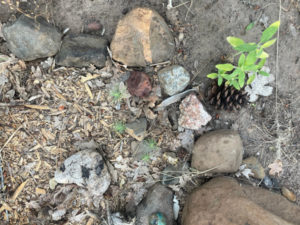
Baby trees are delightful symbols of a better future. Many people choose to become part of the Herland Forest because they want their remains want to become a tree, and baby trees growing on graves is delightful proof that our enhanced natural burial process is working.
Our vision is to transform the Herland Forest into a living memorial, one that affirms nature’s ability to transform death into new life. To do that, we follow two paths: one involves diversification and the other involves rejuvenation.
Diversity: In a conservation cemetery, the only trees that can be planted are the types of trees that are already there. There’s nothing wrong with that–preserving what’s already there is worth doing.
But we believe that there’s something beyond that, something that can build resiliency in the natural world, something that can make a lasting change for the better.

In a permaculture cemetery, flowers, shrubs and trees are introduced to expand the forest’s diversity. We believe that this is important because it enables the forest to better support the bees, butterflies, and the forest’s other pollinators such as Herland’s resident humming birds–that make life possible. Helping these essential partners engage in the dance of life is what we undertake to do.
We’re steadily enhancing the diversity of the Herland Forest by planting different trees on the graves. Here you’ll find dogwoods and aspens, honey locust and hazelnuts, cherries and apples, elderberries and hawthorns, ginkgos and walnuts, all working to increase the resources that support life within the Herland forest.
Rejuvenation: But that’s just one part of our effort to transform a highland forest into something special. As we continue to open up the forest by clearing away the dead branches that would be an existential threat should a wildfire come through, we make room for the forest to assert its vitality. Every garden needs to be thinned and weeded so that the remaining plants have room to fulfill their potential–a forest is just a different kind of garden.
A forest’s ability to transform sunshine, rain, and carbon dioxide into clean air is limited by the availability of certain elements: magnesium, potassium, calcium, etc. Without access to those elements, a forest just limps along. The interment of human remains helps replace the elements that the forest needs in order to thrive.

And the forest is eager to receive those elements. Within a year of a burial, the Herland graves become home to baby pine trees, earnest little oaks and shy firs. The trees compete to take advantage of the graves as seed beds for the next generation of trees. I recently counted the seedlings coming up on one remarkable grave; it turned out to be fostering twenty-three baby pine trees.
This isn’t a passive endeavor; rather, it feels like we’re engaged in a dynamic partnership with the forest. As we work to increase the range of trees that make up the Herland Forest, the forest is simultaneously working to increase the number of young trees that make up the bulk of the forest itself. As each grave becomes a nursery, the forest grows and prospers.

Jessica M England
I think that it is fantastic that you introduce other species of trees, shrubs to your forest along with numerous types of flowers for the bees and the butterflies to pollinate. It is so wonderful what you are doing to Herland Forest, i wish the whole world would do the same exact thing, wouldn’t this be the greatest thing ever.